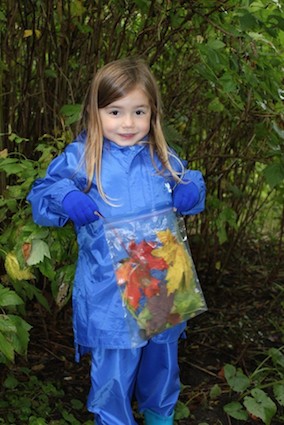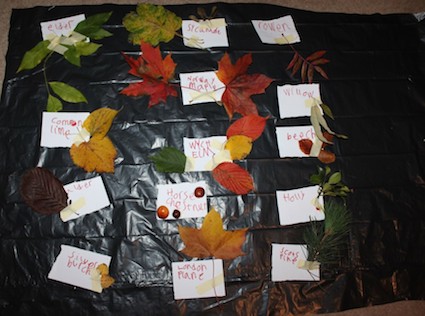
Today’s post is written by Andrea Stevenson – a Canadian teacher who is living in Aberdeen and makes a point of getting out and about with her children. After reading her private family blog, I felt I needed to make use of her skills… 🙂 but please do comment below with your thoughts and feedback.
The aim of a recent leaf scavenger hunt was to find many different kinds of leaves and use them to identify and familiarize ourselves with the types of trees growing in our local area. We set out with the goal of collecting fallen leaves,making sure each leaf was unique. Initially this was a fairly straightforward task, but as our collection grew we had to look more closely at the different features of the leaves in order to determine whether it was a “new” specimen. This often involved pausing to look in our bags and comparing leaves before making a decision.

Finding a leaf that is bigger than your head is always a treat! Curious finds such as large leaves, cones, conkers, berries and seed pods become springboards for a variety of investigations. Why are leaves different sizes and shapes? Where on the tree might this oversized leaf have come from? Why is this berry red? What is the purpose of a conker?
After putting together a nice collection, we set about trying to identify the leaves we had gathered. We brought along a selection of tree identification books borrowed from our local library to help with the process. There are an abundance of identifcation books, apps and online resources available but be sure to obtain guides for your local area. My daughter is very keen to make checklists so it was a perfect opportunity for her to create one. Alternatively, you could create or print a checklist ahead of time that is specific to the trees/bushes in your area. A picture checklist would be particularly helpful for very young children.

As the leaf identification process was taking a little longer than anticpated, we moved the activity indoors to finish up. We arranged the leaves on a large garbage bag at which point my daughter decided she wanted to make a label for each tree and attach the leaves to the label. As with all lessons in teaching, it is important to reflect and identify areas for improvement. We came to realize that some leaves were very difficult to identify out of the field because features such as whether the tree was bearing fruit, what the bark looked like and how the leaves are spaced on the twigs are key to identifying the tree correctly. We recruited the help of our very good friend and Curator of the Cruickshank Botanic Garden, Mark Paterson in helping us to identify a few of the leaves we were having difficulty with.

The number of things children can scavenge outdoors is limitless. Think about how your hunt could change seasonally, in different weather conditions or how you could incorporate a partiular maths or science concept and provide a different context for learning.






























Trackbacks/Pingbacks